Other common names: wheat oats, oat grass, flax grass, poor oats, drake, haver corn, hever, black oats, oats
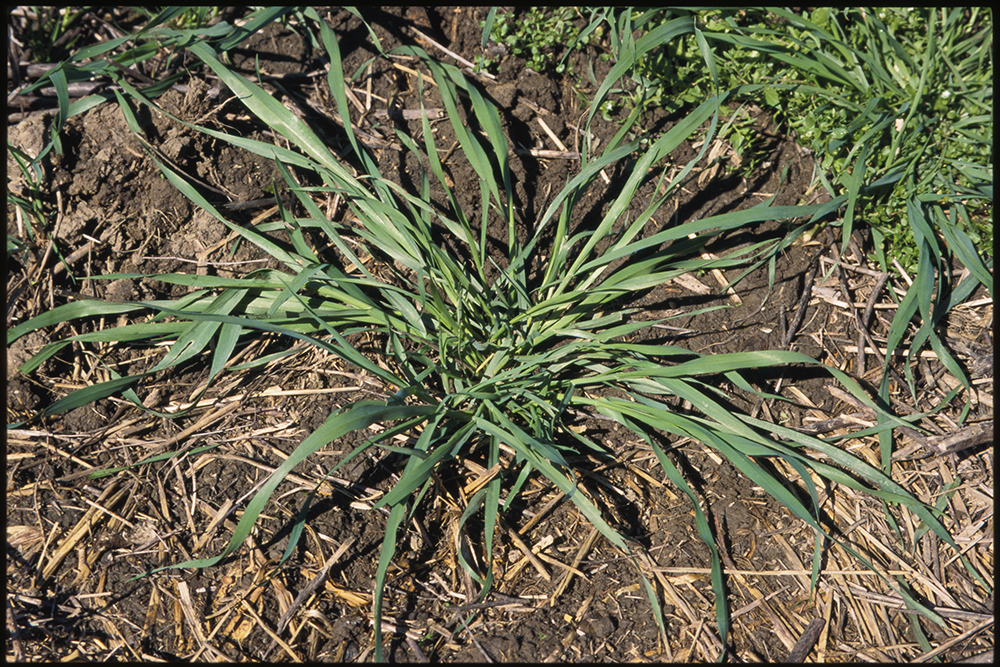
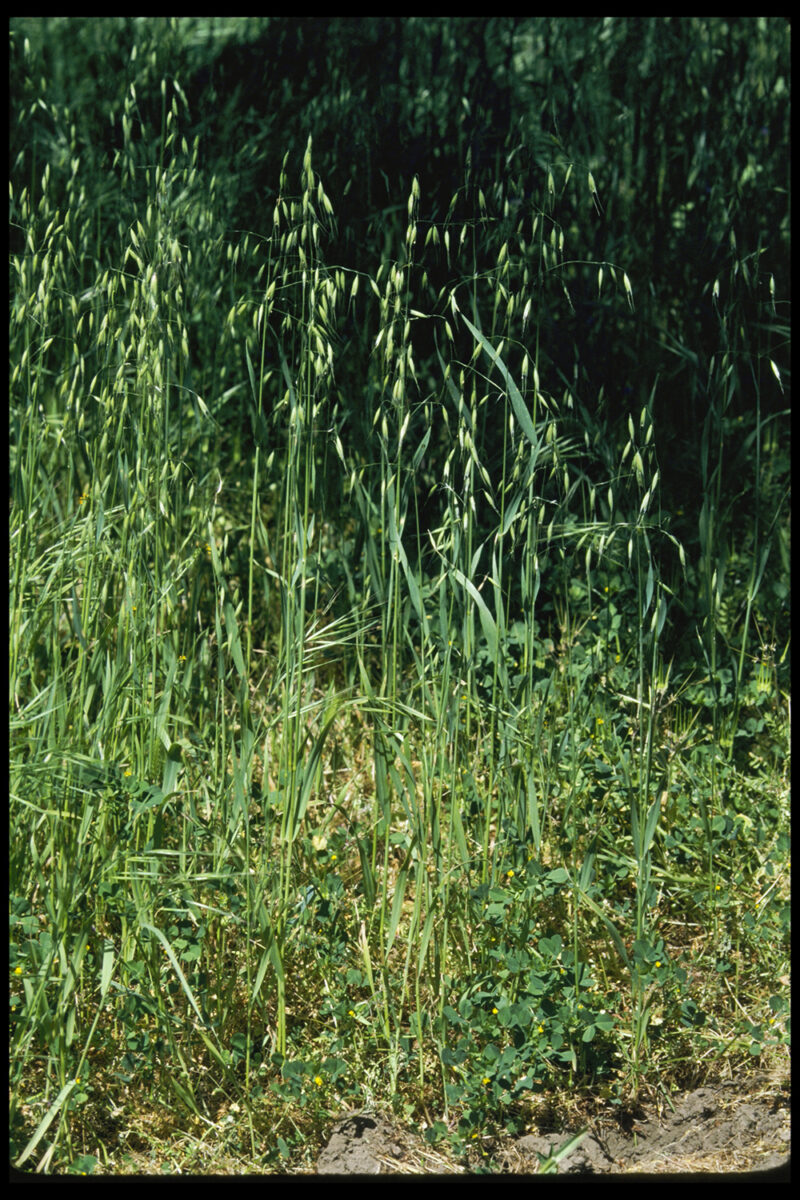
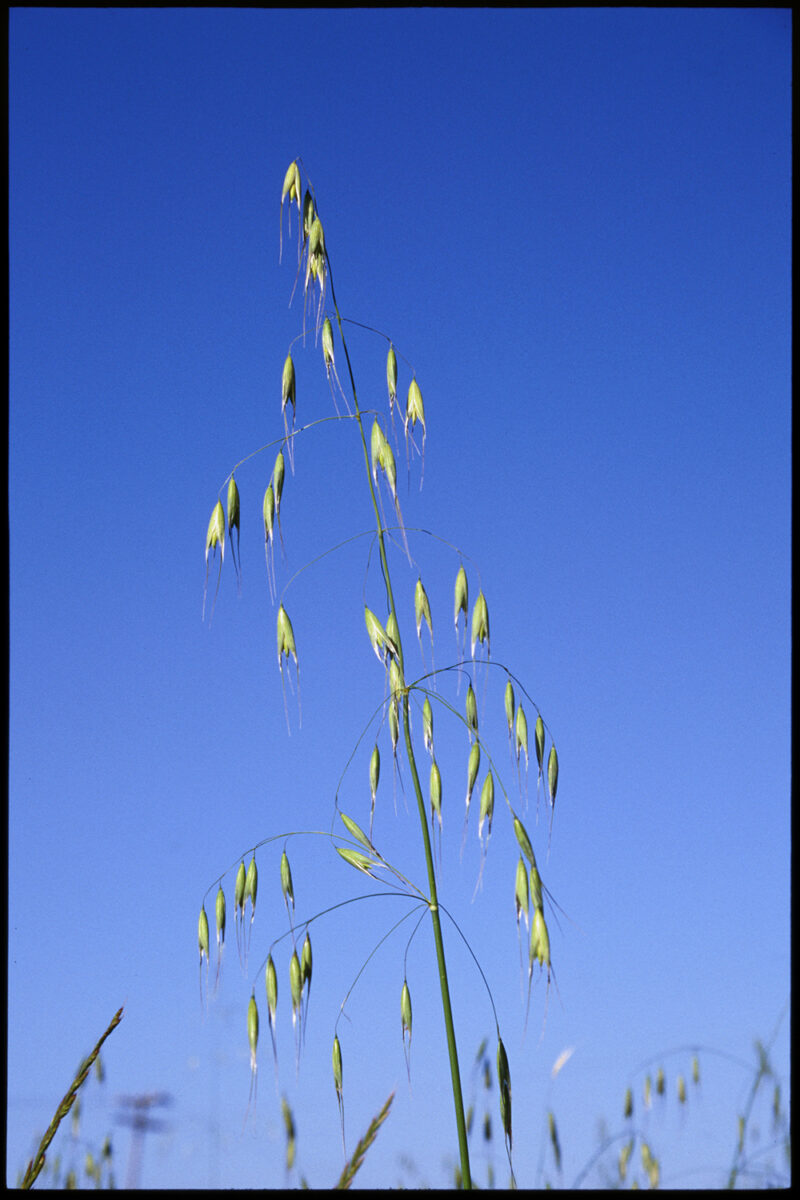
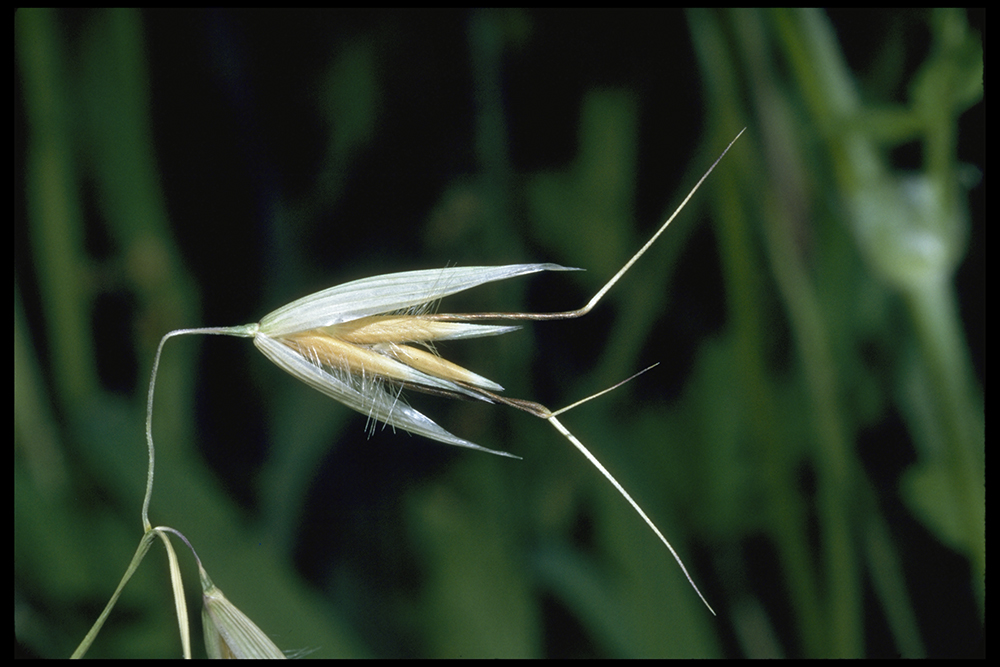
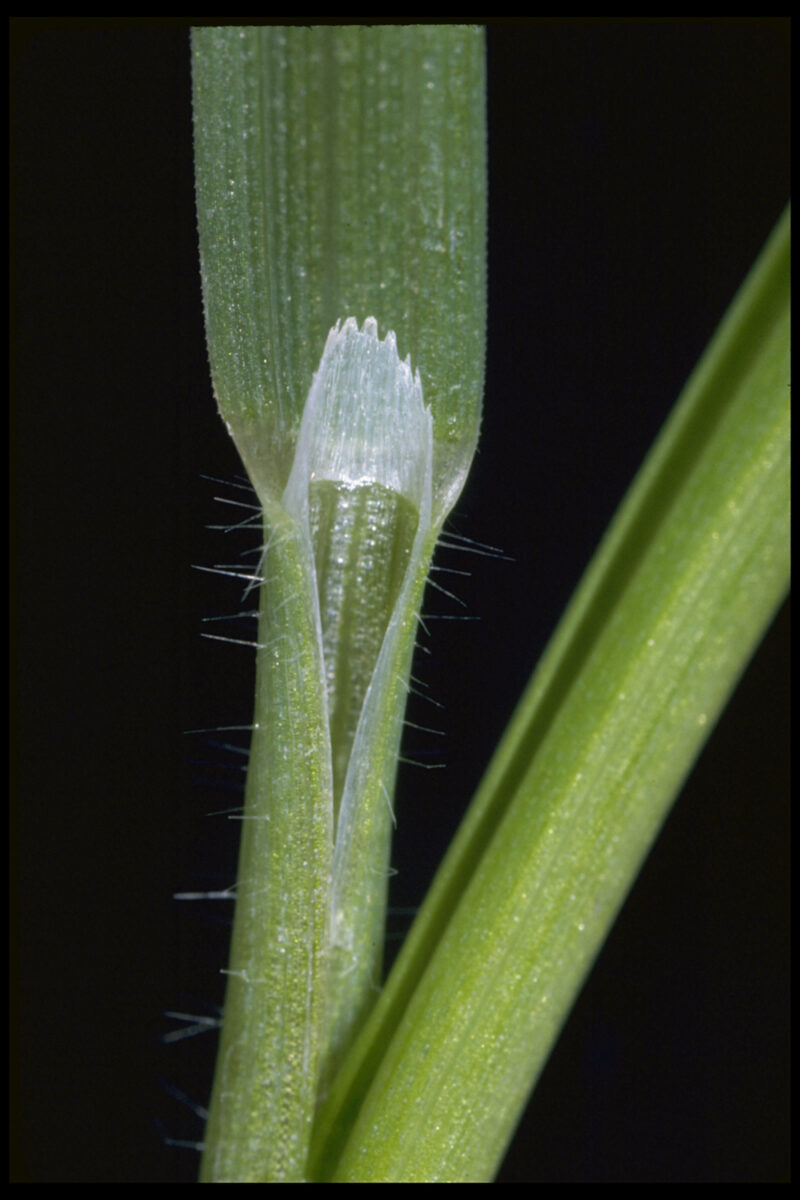
Avena fatua L.
Identification of Wild Oat
Family: Grass family, Poaceae
Habit: Summer annual grass in most of its range; winter annual in California
Description: The seed leaf is oriented vertically and round tipped. True leaves are rolled in the bud, usually emerging with a counter-clockwise twist that is retained to maturity. The ligule is membranous, relatively big and roundly pointed; auricles are absent. Hairs are sometimes present on the dark green blades; when present, small hairs are evenly distributed and large hairs are scattered. The upright, sturdy mature plants have three to five tillers and can reach 1–3.5 feet in height. Flattened sheaths have transparent edges and scattered hairs; they are split open near the collar region. The mature ligule is 0.1–0.25 inch long and pointed, with an uneven, slightly toothed edge. Blades are linear, flat, 2.75–15.75 inches long by 0.25–0.75 inch wide, pointy tipped and rough, with sparse, long hairs present on leaf edges at the base. An extensive fibrous root system is present. The inflorescence is an open, pyramidal, 4–15 inch-long by 8 inch-wide or less panicle. The widely spaced panicles each have nodding spikelets of two to three flowers per branch node. Each spikelet is covered by papery, 1 inch-long outer chaffs, and each flower is encased by a 0.75 inch-long, hairy inner chaff. Inner chaff hairs are white to brown, bristly and scattered. Each inner chaff has a distinctive, 1.25–1.5 inch-long, dark brown to black awn that is bent at a 90-degree angle and twists when in contact with water. Seeds fall off the panicle at maturity with the inner chaff and its long awn still on the seed, leaving a round scar where they were attached to the stem; this scar is sometimes surrounded by short, bristly hairs. Seeds are 0.4 inch long, range in color from yellow-brown to rust to nearly black. The apparent seed includes a thin, tight covering of fruit tissue.
Similar species: Cultivated oats (Avena sativa L.) are most easily differentiated from wild oats when the seedhead is present. Cultivated oats have a narrower, more compact panicle than wild oats, and the non-shattering seed has an awn that is short enough to sometimes appear absent. Vegetatively, the two are nearly impossible to tell apart, especially when the plants are young.
Management of Wild Oat
Although wild oats can be a problem weed in many crops, typically it is a weed of cereal grain-dominated cropping systems. It is particularly problematic in systems in which spring cereal crops are rotated with other drilled crops like canola and flax. Rotation of drilled crops with row crops that can be cultivated between rows like dry beans, potatoes and sugar beets will help decrease wild oat infestations. This will be especially true if precision cultivation tools are used to work close to the crop row.
The tillage regimen greatly affects wild oat management. Wild oat seeds survive poorly on the soil surface. Consequently, unless other weed species are about to go to seed, avoid summer tillage after grain harvest. Even a few weeks of exposure on the surface will decrease the number of viable seeds present. Very shallow harrowing (less than 2 inches) in the fall will stimulate up to half of the current crop of seeds to germinate and subsequently die over the winter in cold climates. In the spring, tillage options depend on the amount of seed produced in the previous crop; if seed production was high, then plowing in the spring will likely bury more seeds than it brings to the surface, whereas if seed production was low, then shallow spring tillage may be preferable. In any case, delaying tillage and planting of either a fall or spring sown crop will reduce the density of wild oat by allowing more seeds to germinate before seedbed preparation. Note that rotary hoeing or tine weeding after crop emergence is not very effective because a large proportion of wild oat seedlings emerge from below the operating depth of these implements. Nevertheless, some control can be achieved using a tine weeder with stiff tines to bury young wild oat seedlings. Not planting every third row and then cultivating the skipped rows has achieved substantial control in European studies.
Since options for mechanical management of wild oat in grain cropping systems are limited, crop competition is critical for management of this weed. In general, winter grains are more competitive against this spring germinating species than spring grains. Among spring drilled crops, the ranking of competitiveness against wild oat is barley-canola-wheat-flax. Usually, long strawed varieties and species (for example, spelt or rye) are more competitive than semi-dwarf varieties. Narrow row spacing and increased seeding density will likely improve yield if wild oat is a problem and can be guaranteed to decrease seed production of the weed.
Wet soils favor wild oat, so tile drainage and practices that avoid compaction have long-term benefits for managing this weed.
Inspect seed grain carefully before you buy it! Wild oat is a common contaminant of most grain crop seed, and even a low percentage of contamination can result in planting thousands of wild oat seeds per acre. Although less than 1% of wild oat mill screenings fed to cattle pass unharmed into the manure, this can still be an enormous number of seeds. Consequently, grinding wild oat grain before feeding and/or composting manure before spreading is advisable.
Ecology of Wild Oat
Origin and distribution: Wild oat probably originated in central Asia, and it presently occurs throughout Europe and Asia except mainland southeast Asia. It has been introduced into Australia, New Zealand, East Africa, North America and most of South America. In North America, wild oat occurs in Alaska and across southern Canada and the United States except for most of the Southeast and the southern Great Plains. It is particularly problematic in the northern prairie region.
Seed weight: Mean population seed weights range 14–24 mg.
Dormancy and germination: Usually, wild oat seeds are dormant when shed from the parent plant, but they lose dormancy over time when exposed to warm, dry conditions. The duration of after-ripening is dependent on complex interactions between wild oat genotype and temperatures during both seed development and after-ripening. Generally, warm, dry conditions hasten after-ripening, and cool, moist conditions delay it. Immersion in water, or alternate wetting and drying, induces secondary dormancy in previously germinable seeds. Once seeds become non-dormant, the optimum temperature for germination is 59–82°F. Nitrate promotes germination of dormant seeds, and applications of N fertilizer have been shown to increase emergence of wild oat in the field. Light or a low oxygen atmosphere inhibits germination.
Seed longevity: The annual mortality rate of wild oat seeds is high, typically in the range of 70–90% per year, but a small fraction of seeds remains viable even after five to nine years. However, in Colorado, no wild oat seeds survived burial for two years, leading to speculation that seeds of Colorado biotypes had less intense dormancy and that, consequently, wild oat was a less serious weed problem south of the 43rd parallel. Wild oat seeds survive poorly on the soil surface, but survival increased when seeds were buried deeper than 4 inches below the soil surface.
Season of emergence: Most emergence occurs in the spring and early fall, but some seedlings emerge throughout the growing season. In Minnesota and North Dakota, wild oat emergence was concentrated primarily in a 28–42 day period after initial emergence began in spring. In Canada, emergence occurred earlier in the spring under conservation tillage than under conventional tillage.
Emergence depth: Optimum recruitment depth is 0.8–2.8 inches, but emergence can occur from seeds as deep as 6–9 inches. Few seedlings emerge from seeds on the soil surface.
Photosynthetic pathway: C3
Sensitivity to frost: Seedlings are frost sensitive but grow well at cool temperatures. Fall emerging plants in the northern prairies are killed by hard frost before they mature, but they can survive the winter in California.
Drought tolerance: Wild oat is relatively sensitive to drought. Even within a field, it tends to be more common in wet depressions than on dry knolls.
Mycorrhiza: Wild oat is mycorrhizal.
Response to fertility: Growth of wild oat is highly responsive to N; in particular, it is more responsive than wheat and similar in responsiveness to canola. Its aboveground growth is moderately responsive to P, being more responsive than wheat but less responsive than canola. Wild oat tolerates soil pH down to 4.5.
Soil physical requirements: Wild oat tolerates a wide range of soils but is most common on clay and loam soils.
Response to shade: Wild oat does not grow in shady environments. In response to shade such as from crop competition, plants grow to the same height, but the number of tillers and seed production are greatly reduced.
Sensitivity to disturbance: Wild oats do not reproduce well from vegetative parts and can be killed easily by cultivation. However, damaged seedlings can regrow in the top 1 inch of soil, presumably if the seed and roots remain intact, allowing access to large seed reserves and soil moisture.
Time from emergence to reproduction: Heading of wild oat plants begins seven to eight weeks after emergence and is controlled more by temperature than by day length. Wild oat plants mature seeds three to four weeks after heading, with seeds at the tip of the main axis of the panicle ripening and shedding first. The capacity of wild oat to mimic the development of the grain crops that it infests, and to shatter mature seeds before grain harvest, ensure its success in these crops.
Pollination: Wild oat mostly self-pollinates, but 1–2% of seeds are produced through cross pollination by wind.
Reproduction: Wild oat produces up to 500 seeds per plant, but 100–150 seeds per plant is more typical. Plants emerging early produced 120 seeds per plant whereas plants emerging three weeks later produced 61 seeds per plant in the Minnesota Red River Valley. Wild oat plants emerging before emergence of a barley crop produced 68–81 seeds per plant, whereas plants that emerged after barley produced 2–58 seeds per plant, depending on the barley growth stage at which the wild oats emerged. Plants subjected to intense competition from a vigorous barley crop produced 20–30 seeds per plant. Seeds that mature in the crop understory are 10–30% less viable than seeds that mature above the crop leaf canopy.
Dispersal: Seeds fall on the ground without any natural means of dispersal. For thousands of years, the main mode of spread has been in contaminated seed grain. The species also commonly moves about on combines. Only a low percentage of wild oat seeds passes through cattle in a viable condition.
Common natural enemies: The natural enemies of wild oat are similar to those of grain crops.
Palatability: The seeds are edible. Wild oat mill screenings are commonly sold as a feed grain and have about 90% of the nutritional value of domestic oat. Wild oat is palatable forage, and extensive tracts of annual grasslands dominated by wild oat are harvested for hay in California.
Summary Table of Wild Oat Characteristics
| Wild oat | ||||||||
|---|---|---|---|---|---|---|---|---|
| Growth habit | Seed weight (mg) | Seed dormancy at shedding | Factors breaking dormancy | Optimum temperature for germination (F) | Seed mortality in untilled soil (%/year) | Seed mortality in tilled soil (%/year) | Typical emergence season | Optimum emergence depth (inches) |
| medium | 14-24 | Yes | wst, ni | 59–82 | 70–90 | na | spring and early fall | 0.8–2.8 |
| Photosynthesis type | Frost tolerance | Drought tolerance | Mycorrhiza | Response to nutrients | Emergence to flowering (weeks) | Flowering to viable seed (weeks) | Pollination | Typical & high seed production (seeds per plant) |
| C3 | low | low | yes | high | 7–8 | 3–4 | self, can cross | 100 & 500 |
Table Key
General: The designation “–” signifies that data is not available or the category is not applicable.
Growth habit: A two-word description; the first word indicates relative height (tall, medium, short, prostrate) and second word indicates degree of branching (erect, branching, vining).
Seed weight: Range of reported values in units of “mg per seed.”
Seed dormancy at shedding: “Yes” if most seeds are dormant when shed, “Variable” if dormancy is highly variable, “No” if most seeds are not dormant.
Factors breaking dormancy: The principle factors that are reported to break dormancy and facilitate germination. The order of listing does not imply order of importance. Abbreviations are:
scd = seed coat deterioration
cms = a period subjected to cold, moist soil conditions
wst = warm soil temperatures
li = light
at = alternating day-night temperatures
ni = nitrates
Optimum temperature range for germination: Temperature (Fahrenheit) range that provides for optimum germination of non-dormant seeds. Germination at lower percentages can occur outside of this range. The dash refers to temperature range, and the slash refers to alternating day/night temperature amplitudes.
Seed mortality in untilled soil: Range of mortality estimates (percentage of seed mortality in one year) for buried seeds in untilled soil. Values were chosen where possible for seeds placed at depths below the emergence depth for the species and left undisturbed until assessment. Mortality primarily represents seed deterioration in soil.
Seed mortality in tilled soil: Range of mortality estimates (percentage of seed mortality in one year) for seeds in tilled soil. Values were chosen for seeds placed within the tillage depth and subjected to at least annual tillage events. Seed losses are the result of dormancy-breaking cues induced by tillage, germination and deterioration of un-germinated seeds.
Typical emergence season: Time of year when most emergence occurs in the typical regions of occurrence for each weed. Some emergence may occur outside of this range.
Optimum emergence depth: Soil depths (in inches below the soil surface) from which most seedlings emerge. Lower rates of emergence usually will occur at depths just above or just below this range.
Photosynthesis type: Codes “C3” or “C4” refer to the metabolic pathway for fixing carbon dioxide during photosynthesis. Generally, C3 plants function better in cooler seasons or environments and C4 plants function better in warmer seasons or environments.
Frost tolerance: Relative tolerance of plants to freezing temperatures (high, moderate, low).
Drought tolerance: Relative tolerance of plants to drought (high, moderate, low).
Mycorrhiza: Presence of mycorrhizal fungi. “Yes” if present; “no” if documented not to be present, “unclear” if there are reports of both presence and absence; “variable” if the weed can function either with or without, depending on the soil environment.
Response to nutrients: Relative plant growth response to the nutrient content of soil, primarily N, P, K (high, moderate, low).
Emergence to flowering: Length of time (weeks) after emergence for plants to begin flowering given typical emergence in the region of occurrence. For species emerging in fall, “emergence to flowering” means time from resumption of growth in spring to first flowering.
Flowering to viable seed: Length of time (weeks) after flowering for seeds to become viable.
Pollination: “Self” refers to species that exclusively self-pollinate, “cross” refers to species that exclusively cross-pollinate, “self, can cross” refer to species that primarily self-pollinate, but also cross-pollinate at a low rate, and “both” refers to species that both self-pollinate and cross-pollinate at relatively similar rates.
Typical and high seed production potential: The first value is seed production (seeds per plant) under typical conditions with crop and weed competition. The second value, high seed production, refers to conditions of low density without crop competition. Numbers are rounded off to a magnitude that is representative of often highly variable reported values.
Further Reading
Bullied, W.J., A.M. Marginet and R.C. Van Acker. 2003. Conventional- and conservation-tillage systems influence emergence periodicity of annual weed species in canola. Weed Science 51: 886–897.
Harker, K.N., J.T. O'Donovan, R.B. Irvine, T.K. Turkington and G.C. Clayton. 2009. Integrating cropping systems with cultural techniques augments wild oat (Avena fatua) management in barley. Weed Science 57: 326–337.
Sharma, M.P. and W.H. Vanden Born. The biology of Canadian weeds. 27. Avena fatua L. Canadian Journal of Plant Science 58: 141–157.

